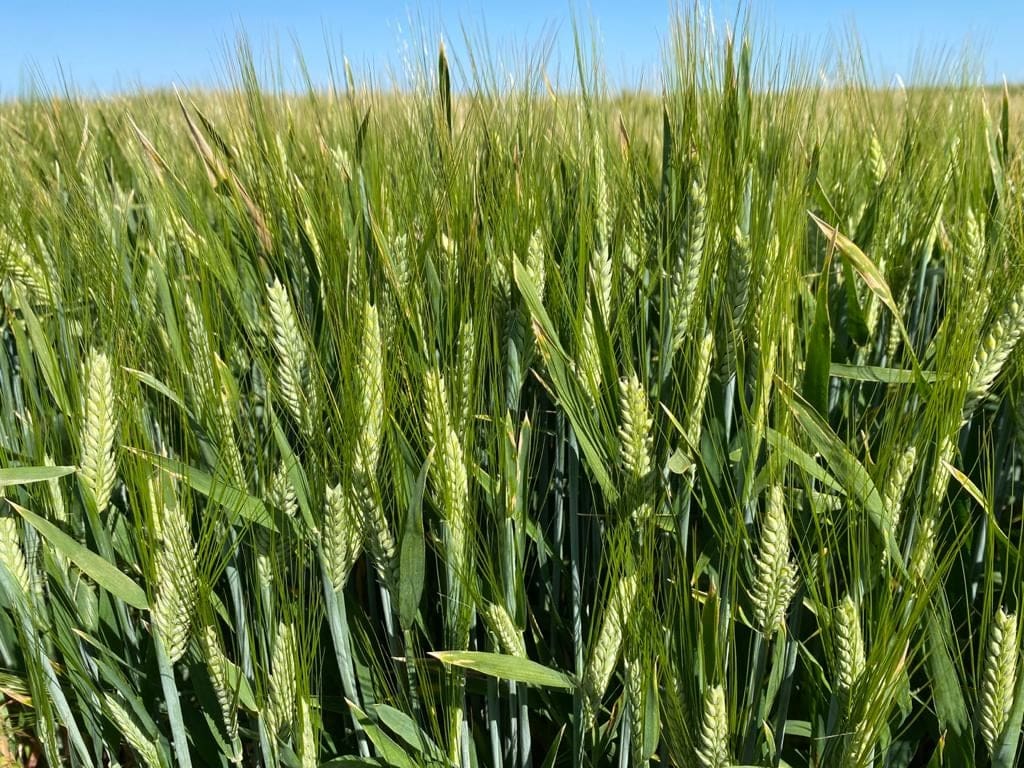
A crop of barley near Goondiwindi photographer in early September. Photo: CHS Broadbent
A SLOWDOWN in export and domestic buying for wheat and barley in the coming quarter has allowed prices for both to ease in the past week to reflect a softening in global values.
The big carry-out of both crops in Victoria and southern and central New South Wales has seen southern values drop by up to $15 per tonne.
Domestic consumers are seeing more downside than upside to values ahead of and during the harvest slot, so are in no hurry to buy.
Growers in Victorian port zones are believed to be undersold on new-crop cereals for this time of year, and will pick out market spikes to advance coverage.
| Nearby | New-crop | |
| Barley Downs | $288 down $4 | $295 down $2 |
| Wheat Downs | $342 down $3 | $335 steady |
| Sorghum Downs | $305 up $3 | $285 steady |
| Barley Melbourne | $278 down $12 | $285 down $10 |
| Wheat Melbourne | $355 down $5 | $340 down $15 |
Table 1: Indicative delivered prices in Australian dollars per tonne.
CQ wheat leads export push
New-crop wheat is being accumulated for shipment out of Central Queensland’s two grain ports, Gladstone and Mackay, now that harvest is under way.
Trade sources report the comparable pricing is at least $10/t above the domestic feed market, with H1, H2. APH1 and APH2 in strong demand as markets in Asia and beyond scream out for protein wheat to counter North America’s drought-reduced shortfall.
Bulk wheat storages in southern Queensland are now into their final week or two of clean-out ahead of new crop arriving at depots on the Western Downs, and towards the NSW border.
This has kept road transport in tight supply, as the last of Queensland’s carry-out moves to port.
With export buyers jumping up and down for wheat and sorghum for nearby shipment, barley continues to be the feed market’s number one choice.
Queensland feedlots continue to road-freight barley from central and south-central NSW booked some weeks ago.
Barley in grower storages closer to home has all but sold out, and is in minimal demand in the near term now that most consumers are covered into the harvest slot.
“Old-crop markets are starting to lose a little bit of shine,” Delta Grain’s Tom Vanzella said.
“Consumers are looking towards new crop now the headers are starting to roll.”
Top-grade sorghum has traditionally cost less than barley, but remains too expensive for most poultry customers to consider.
“Barley is still a cheaper product than sorghum, and poultry customers are still wanting to own barley.”
Mr Vanzella said feed markets were holding up reasonably well in the face of what looks like another big harvest in NSW, with limited selling by growers to date
“The opportunity for growers to make good forward sales on feedgrain was a couple of weeks ago, and if we see the market rally by $5-$15/t, it might bring a bit more out.”
A lack of rain in recent weeks has taken some upside off yield potential in most regions in southern Queensland, and some in northern NSW.
Harvest on the plains of northern NSW is expected to be in full swing by early November.
Sales spike in south
Excellent canola and lentil prices have seen southern growers focus their forward sales program on these commodities, and drag the chain on barley and wheat sales.
With the full extent of Canada’s drought-affected crop now seen to have factored into global wheat and barley markets, southern growers are now keen to sell because the bull runs of recent months look likely to be over.
“There’s definitely a softening in the market,” Peter’s Commodities trader Peter Gerhardy said.
“We’re not home yet, but we know there’s old season grain still out there, and there’s going to be a massive carryover in Victoria and NSW.”
Mr Gerhardy said this made domestic consumers comfortable about their level of coverage.
“Markets have come off probably $10-$15 in the past 10 days, and there seems to be a lot more sellers than buyer; that’s growers, and trade sellers too.”
Another trader said the attractiveness of new-crop Australian wheat on top of new-crop shipments of canola already booked, meant barley was struggling to find spaces in shipping stems before March.
“Harvest pressure is on its way, and consumers are well covered.
“The grower is undersold, and we’re not seeing a lot of competition for barley.
“Barley is trying to get some of those export slots from wheat, but it won’t be easy, and the domestic market knows that.”

HAVE YOUR SAY